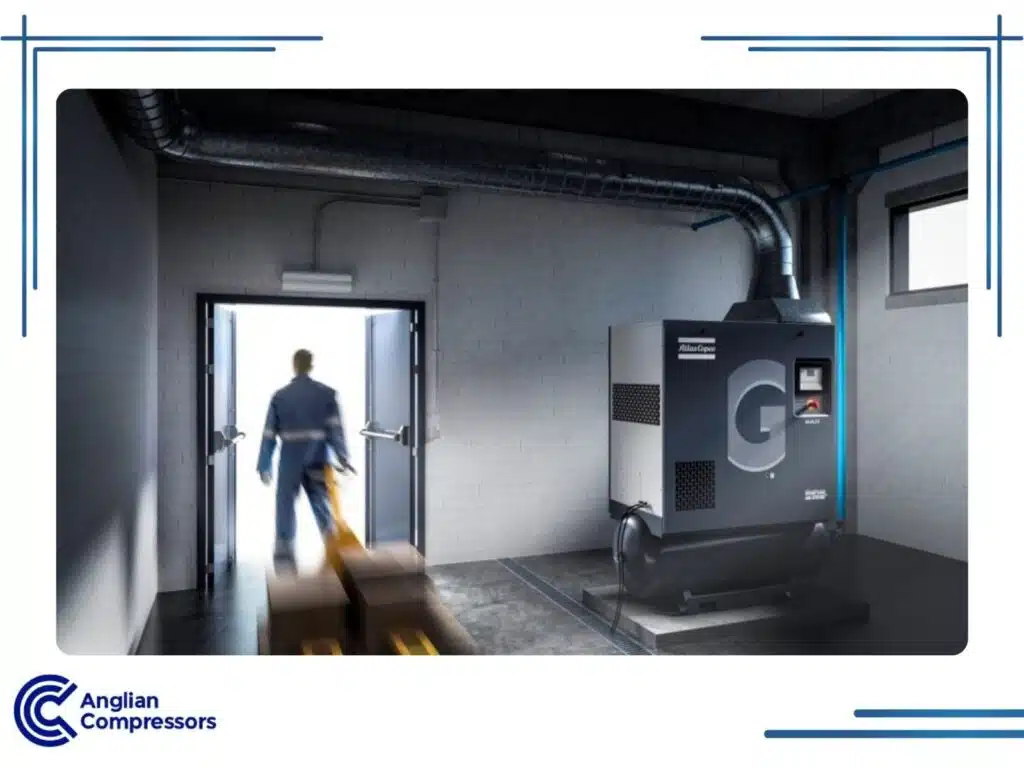PET Air Compressor Sizing
Plants and other manufacturing facilities making use of bottle production rely on polyethylene terephthalate (PET) air compressor systems. The sizing of this type of compressor is critical, both to manage sufficient production volume and to deliver the necessary, consistent air pressure for PET bottle production.
Proper sizing directly impacts operational efficiency, energy consumption, and production quality. Facilities can optimise energy use and minimise downtime by ensuring a correctly sized compressor.
Most of the running costs for any type of air compressor consist of the energy it consumes. While heat recovery saves money in the long run, the initial approach should always be to size the PET compressor system properly for the needs of the plant.
The Risks of Using an Improperly Sized PET Air Compressor
Air compressors, like other large industrial equipment with moving parts, have optimal functionality. Deviation from optimal sizing can result in inefficiencies, unnecessary wear, or higher operational costs.
Infrequent or Overuse Risks
If you run air compressors too infrequently, they’ll break down more often due to irregular use. This defies low maintenance objectives and increases maintenance costs long-term, even if they only produce low-pressure air.
On the opposite end, the potential wear and tear could become excessive when running compressed air equipment beyond it’s expected runtime hours. With that said, air compressors are built to be robust, reliable machines.
Overloading compressors may lead to reduced operational lifespans and costly unscheduled maintenance.
Size Matters with Air Compressors
Choosing the right size air compressor for PET bottle-blowing machines is essential for efficiency, performance, and cost control. The wrong size – too large or too small – can lead to wasted energy, production issues, and higher maintenance costs.
The Risks of an Undersized Compressor
An undersized high-pressure PET compressor struggles to meet air supply demands, leading to:
- Inconsistent bottle formation due to low pressure.
- Overheating and frequent breakdowns, shortening equipment lifespan.
- Higher maintenance costs from excessive wear and tear.
The Pitfalls of an Oversized Compressor
An oversized oil-free air compressor wastes energy and increases operational costs:
- Short cycling damages components, leading to higher servicing needs.
- Excess energy use raises costs, even when running below capacity.
- Reduced heat recovery efficiency makes energy savings harder to achieve.
Key Considerations for the Right Fit
The air compressor you need must align with the following:
✔ Production volume – matching air supply and tank capacity prevents inefficiencies.
✔ Pressure consistency – PET compressed air systems require 18 to 40+ bar.
✔ Energy efficiency – operating at specific air flow rates minimises waste.
Properly sizing a reliable air compressor ensures efficient PET production, reduces costs, and prevents downtime – keeping operations smooth and profitable.
Does a Compressor Booster Help to Meet Pressure Requirements?
What about boosters? It’s worth noting that a booster is often included in air systems. These increase air pressure levels from what a compressor initially produces.
However, a booster cannot compensate for an incorrectly sized primary compressor. A properly configured combination of a base compressor and booster ensures efficiency and reliability.
Nevertheless, they aren’t a cure-all for a pressure drop, or an air compressor that cannot produce enough high-pressure air to meet pressure requirements.
Proper PET Compressor Sizing Relies on Pressure and Flow
Regardless of whether you’re considering the suitability of an existing air compressor to support PET bottle production, or it represents a new plant investment, required pressure and flow needs are where the rubber meets the road.
Precise calculations of pressure and flow requirements and consideration of downstream processes like bottle cooling and blow moulding are essential for operational success.
Without a significant degree of accuracy on the estimates for these, they will be too inaccurate to use.
Pressure Requirements Differ for PET Air Compressors
Pressure equals force. Compressing air takes considerable energy too.
There are different methods for measuring the pressure level, but the most common are PSI or bar. The former is the Imperial system, and the latter is part of the Metric system.
One important distinction for buyers generally familiar with air compressors is that pressure level needs differ markedly for general commercial applications vs PET bottling plants. Whereas some commercial uses of compressed air might find under 10 bar as adequate, the pressure range needed for industrial PET bottle blowing can begin at 18 bar and reach 40+ bar for a higher-pressure air compressor.
From an energy expense standpoint, each bar of added pressure considerably increases a company’s electricity bill. This is why in a rising energy cost environment, companies are looking at operating at lower pressure levels for energy savings, wherever possible.
Know Your Flow Requirements
They establish flow based on the volume of compressed air that a compressor produces. When talking about flow, we must first mention a little about flow measurements.
Cubic feet per minute (CFM) is how free air delivery is tracked. CFM puts a number on the airflow capacity of an air compressor at a fixed pressure level. The pressure capability of the air compressor is also a factor.
Alternatively, cubic meters per hour (m3/h) or litres per second (l/s) are valid measurements within the industry too.
Obtaining the air demand and how many pieces of high-pressure air equipment and pneumatic-related tools or machines are present is the place to start. This is meaningful when owning a compressor, to rmaintain lower energy costs.
For the booster, a separate calculation is needed. This relates to the number of PET bottle machines and the volume of bottles to produce. This is vital for determining the flow needs for the booster.
Calculating PET Compressor Sizing Correctly
The right air compressor size is crucial for efficiency, cost control, and bottle quality. Miscalculations lead to downtime, defects, and wasted energy.
Key Factors in Compressor Selection
- Pressure Requirements – high-pressure air (18 to 40+ bar) is essential for PET bottle blowing.
- Airflow and Volume – the quantity of air (measured in CFM or m³/h) must match production demand.
- Duty Cycle and Load – rotary screw air compressors or two-stage air compressors suit continuous use.
- Bottle Design and Machine Speed – faster lines require a consistent air supply to avoid defects.
- Environmental Conditions – temperature, humidity, and altitude affect compressor performance.
- Cooling and Booster Needs – Atlas Copco GA and similar compressor solutions optimise PET compressed air.
Why Correct Sizing Matters
- Undersized compressors cause pressure drops, overheating, and breakdowns.
- Oversized systems lead to short cycling, energy waste, and inefficiencies.
A well-sized electric air compressor improves efficiency, reduces costs, and ensures smooth production.
Consulting experts, like Anglian Compressors, ensure these factors are accurately addressed, helping to avoid costly errors.

Seek Assistance from Anglian Compressors
It is much better to seek a PET air compressor consultation with Anglian Compressors than try to go it alone.
As a practical matter, many factors and aspects go into a proper calculation. Given the financial consequences of making a bad calculation, and acquiring a poorly chosen PET air compressor, working with a specialist to figure out your company’s needs is safer. To determine your best options, get in touch to discuss it with a trained air compressor professional.
Contact our team today to determine the best PET air compressor for your needs.
FAQ
How do I choose the right air compressor for PET bottle production?
When selecting a compressor for PET bottle production, consider the total air demand and the high-pressure air requirements, typically ranging from 18 to 40+ bar. A blowing compressor is designed for PET applications, ensuring consistent airflow and pressure. It is also essential to match the compressor capacity with the production line’s needs to avoid underperformance or inefficiency.
What role does an air dryer play in maintaining air quality?
An air dryer, such as a refrigerated air dryer or desiccant air dryer, is critical for removing moisture from compressed air, which is vital for maintaining the quality and longevity of the equipment. In PET production, maintaining air quality is essential to prevent contamination and preserve the integrity of the bottle-blowing process. Dry, clean air helps avoid condensation issues, which could impact production.
What are the key factors determining the air needed to blow PET bottles?
The amount of compressed air required to blow PET bottles depends on the bottle’s size, shape, and thickness, as well as the speed of the production line. A high-pressure air compressor is typically used, and the air pressure is measured in pounds per square inch (PSI) or bar. Accurately calculating air consumption ensures that the compressor output meets the air requirements without wasting energy or underperforming.


